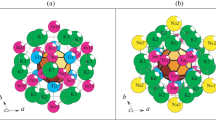Abstract
For potassium dihydrogen phosphate and its deuterated analogue, trial versions of model clusters have been proposed to analyze the influence of domain walls on the thermodynamic properties of these ferroelectric materials. Based on the results of quantum-chemical calculations of the energy of these systems, represented as pentameric clusters with 16 strong H-bonds, key reasons for the possible influence of such inhomogeneities have been formulated. Despite the artificial nature of the proposed clusters and the simplified method of their quantum-chemical modeling considering only pseudospin configurations that correspond to the ice rule, three basic factors of the influence of the domain wall on thermodynamics can be assumed. Crucial are the violation (or preservation) of the key features of the symmetry of the crystal lattice, the preservation of the geometric parameters of hydrogen bonds, and the relative concentration of these bonds in domain walls as compared to domains.



Similar content being viewed by others
REFERENCES
L. N. Kamysheva and S. N. Drozhdin, Ferroelectrics 71, 281 (1987).
E. Nakamura, Ferroelectrics 135, 237 (1992).
J. Bornarel, Ferroelectrics 54, 245 (1984).
J. Bornarel, Ferroelectrics 71, 255 (1987).
M. Lains and A. Glass, Ferroelectrics and Related Materials (Mir, Moscow, 1981) [in Russian].
B. A. Strukov and A. P. Levanyuk, Physical Foundations of Ferroelectric Phenomena in Crystals (Nauka, Moscow, 1983) [in Russian].
J. M. Ziman, Models of Disorder (Cambridge Univ. Press, 1979).
V. G. Vaks, Introduction to the Microscopic Theory of Ferroelectrics (Fizmatlit, Moscow, 1973) [in Russian].
R. Blints, Ferroelectrics and Antiferroelectrics. Lattice Dynamics (Mir, Moscow, 1975) [in Russian).
T. Yu. Mikhaylova, N. N. Breslavskaya, and S. P. Dolin, Russ. J. Inorg. Chem. 62, 935 (2017). https://doi.org/10.1134/S003602361707004X
S. P. Dolin, T. Yu. Mikhailova, and N. N. Breslavskaya, Russ. J. Inorg. Chem. 65, 1015 (2020). https://doi.org/10.1134/S0036023620070050
S. P. Dolin, T. Yu. Mikhailova, and N. N. Breslavskaya, Russ. J. Inorg. Chem. 65, 540 (2020). https://doi.org/10.1134/S0036023620040221
S. P. Dolin, T. Yu. Mikhailova, and N. N. Breslavskaya, Russ. J. Inorg. Chem. 66, 707 (2021). https://doi.org/10.1134/S0036023621050041
J. C. Slater, J. Chem. Phys. 9, 16 (1941).
M. Tokunaga and T. Matsubara, Prog. Theor. Phys. 38, 581 (1966).
S. A. Gridnev, L. N. Kamysheva, and A. S. Sidorkin, Ferroelectric Crystals of the X 2 PO 4 Group (Voronezh, 1981) [in Russian].
A. S. Sidorkin, Domain Structure in Ferroelectrics and Related Materials (Fizmatlit, Moscow, 2000) [in Russian].
A. S. Sidorkin, Solid State Phys. 31, 293 (1989).
D. Mattis, Theory of Magnetism (Mir, Moscow, 1967) [in Russian].
R. J. Nelmes, J. Phys. S: Solid State Phys. 18, L711 (1985).
R. J. Nelmes, Z. Tun, and W. F. Kuhs, Ferroelectrics 71, 125 (1987).
R. J. Nelmes, J. Phys. C: Solid State Phys. 21, L881 (1988).
J. Bornarel and R. Cach, J. Phys.: Condens. Matter 15, 4371 (2003).
J. Bornarel and B. Torche, Ferroelectrics 76, 201 (2004).
T. Yu. Mikhaylova, N. N. Breslavskaya, and S. P. Dolin, Russ. J. Inorg. Chem. 63, 61 (2018). https://doi.org/10.1134/S0036023618010060
T. Yu. Mikhailova, N. N. Breslavskaya, and S. P. Dolin, Russ. J. Inorg. Chem. 62, 1600 (2017). https://doi.org/10.1134/S0036023617120130
N. S. Afonnikova, V. V. Borovikov, I. M. Shmytko, Solid State Phys. 29, 813 (1987).
Funding
The work was supported by the Russian Foundation for Basic Research (project no. 19-03-00443) and was partially performed in the framework of the State assignment of the Kurnakov Institute of General and Inorganic Chemistry RAS in the field of basic research (no. 44.2).
Author information
Authors and Affiliations
Corresponding author
Ethics declarations
The authors declare no conflicts of interest.
Additional information
Translated by G. Kirakosyan
Rights and permissions
About this article
Cite this article
Dolin, S.P., Mikhailova, T.Y. & Breslavskaya, N.N. Possibilities of Quantum-Chemical Modeling of Domain Boundaries in the Cluster Approximation of the Ising Model for Materials of the Potassium Dihydrogen Phosphate Family. Russ. J. Inorg. Chem. 67, 1283–1289 (2022). https://doi.org/10.1134/S0036023622080083
Received:
Revised:
Accepted:
Published:
Issue Date:
DOI: https://doi.org/10.1134/S0036023622080083




